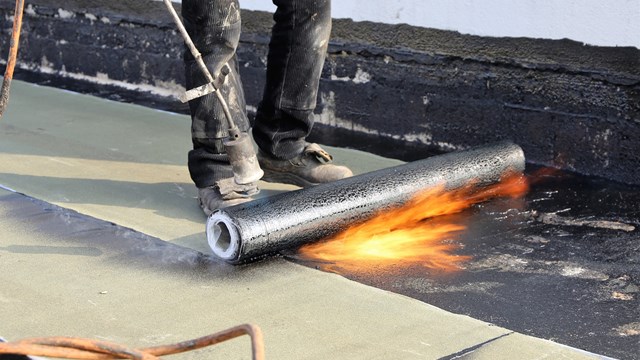The signs, they are everywhere. They give elegance and style to the names of our buildings and communities. They earn extra income for our buildings with advertisements, and they point out the location of our commercial tenants on the ground floor. They give us direction, they entertain us, they attract our attention. In major cities, they are ubiquitous.
Choosing the Right Sign
Once a sign or logo has been designed, it may seem as though installation might be an easy next step. Just raise it and install it, right? Considering the size and weight of most large signs and the height at which they usually are mounted, exterior signs travel a lengthy road before they finally are put in place. As Carol Wade, Marketing Director for Watchfire Signs in Danville, Illinois, says, “They’re not something you put into your shopping cart and just check out.”
The first step comes in selecting the best type of sign for the situation and for the building itself. “For exterior signs on residential buildings, we usually use an aluminum substrate,” says Chris Hoehn, Co-Owner at Morris Sign Company in Whippany, New Jersey. “If it is for a more upscale building, we would use a high-density urethane foam. Banners are used as temporary signs because they cannot be guaranteed in bad weather.”
The breadth of signs available continues to grow. “Take a walk down the street in New York City and look around,” says Harriet Black, Founder and CEO of Audrey Signs Inc., in Manhattan. “Some are just simple metal, and then there’s the fancy-pants stuff like LED and 3D and halo-lit, which has the light coming from the back so you get a glow around the letters. And that’s just the tip of the iceberg.”
Black goes on to say that “LED signs are becoming more popular -- if you can get city approval.” An LED or light-emitting diode can be both brighter and more energy efficient than incandescent bulbs, and does not burn out because unlike incandescent lights, they do not have filament. However, depending on the location of the building, they may or may not be allowed.
Wade adds that LED signs can be used to meet a broad range of needs -- even to the point of becoming something of an amenity themselves. “With residential facilities, we’ve seen them used as informational signs, showing off photos of great kitchens and amenities. And we’ve seen the product used as an architectural asset. We had a very large sign on a residential building in Toronto that does nothing but show artwork. It’s a canvas that changes every minute.”
LEDs also can be quite cost effective. “Compared to bulb-based message centers, these signs weigh less, last longer, and use significantly less energy than other electronic signs,” says Wade. “They burn for 100,000 hours – they last a really long time.” Wireless technology also means that the signs can be updated and modified easily from any computer or device. “They’re a great advertising investment,” she adds.
Zoning can be the deciding factor in whether an LED sign or other illuminated display is available or right for a given building. “You can’t always have lighting on every street,” says Black. “You can only have illumination in the proper zoning. And if you do it wrong (and violate that zoning), it’s an expensive thing to fix. It can be thousands of dollars. You have 30 days to cure and if it’s not fixed, you’ll pay additional fines.”
Paperwork and Planning
Once the most appropriate type of sign is selected and the design is completed, the paperwork side of the equation comes into play. Drawings must be prepared, as well as engineering reports ensuring that the location, materials, and design all add up to safety for residents, pedestrians, installers, and even the building structure itself.
This is also the point in time when a professional expediter may be hired by the sign designers or building owners. Expediters are experts in municipal code requirements and submittal processes, working as a liaison between project managers, city planners, and other key figures to, as their name suggests, expedite the process and make sure no loose ends are dangling at any point in the project.
“The process has always been difficult,” says Black. “I work with expeditors to get it done. There’s a lot of paperwork required from the owners of the building. Say a Mr. Katz owns the building. In order for us to get clearance, I have to have him sign off on it, and then we sign, and then the engineers from the city have to sign. For a first-time person asking for a sign to go up, it becomes a little bit of a jungle. We have to walk them through the paperwork.”
Even outside the big cities, exterior signs will require approvals. Says Hoehn, “Usually any type of permanent sign requires approval from the town, and getting the proper approval and permits is a must. Most times, the customer prefers to get the permits themselves, but we can do it as well. We always help with the paperwork either way, because many times it requires drawings.”
When it comes to determining where a sign will be installed, it is important to find the ideal place on the building -- not only a spot that is obviously visible to passers-by, but also one that takes into consideration the physical needs of the structure itself. “Any type of flat surface is better for appearance, but also for securing the sign to the building,” say Hoehn. “Sometimes uneven stonework causes problems with the installation.”
Because electronic signs, including LEDs, can be updated, they also benefit from careful analysis of location before they are put into place. “You can analyze the site, look at how fast foot traffic is passing by, look at dwell time,” says Wade. “Location, height, foot traffic, and all of that will help determine size and resolution for the sign.” In short, when a sign is going to be a long-term part of the building, it is important to look at it – quite literally – from all angles.
Raised Into Place
When it comes to the actual physical installation of the sign, sign makers and riggers will look at the type of materials being used and then “use screws that are appropriate for that substrate,” says Hoehn. “When putting something in the air, you want to make sure it is secure so nothing comes down.” The holes they drill “are usually very small,” he adds, which means that should the sign eventually be taken down, the only thing needed to repair the original surface of the building is some caulk to fill those holes.
For LED signs, “You have to have a solid structure to attach the LED sign to,” says Wade. “And you have to be able to get power to the site. Communication is wireless now, so there is no fiber optic cable to bury. We can mount them on a poll or a wall. They’re very flexible in how they can be mounted.”
When it comes to installing any type of sign, whether an old-school billboard or state-of-the-art electronic system, the work must be done by licensed riggers, says Black. If for some reason a building tries to do it themselves or have a member of the building staff attempt it, then the results not only could be expensive, but very serious indeed. Or, as Black says, “Do not pass go, go straight to jail.”
In New York, these special riggers must pass a practical exam that shows they understand the rules and regulations governing hoisting and rigging, as well as safety measures and accident prevention. This is one important way that cities and municipalities can reduce the risk of injury to everyone, from the installers to the people walking by on the street below.
For buildings, which shoulder the burden of liability when it comes to exterior signage, following the rules also can reduce their legal risks later. That includes proper upkeep of the signs as well. “After the signs are installed, the building manager is responsible for the upkeep,” says Hoehn.
Ultimately, installing exterior signage -- either as a way to promote the building or as a way to earn extra income -- can be a positive and exciting experience, lending new visual zip to the residential community, the street, and sometimes even the whole neighborhood. However, it is a lengthy process and requires patience from all involved. “If you’re lucky, from the day the client says yes to the design, and then you do all the drawings and measurements and paperwork, it can take from three to five weeks to get the sign up,” says Black.
In the end, with the colorful lights giving the building a warm, new glow, it will all have been worth it. The right design and location can transform a formerly bare wall into an eye-catching work of art. Good signs, as Wade says, “have the power to become landmarks.” What a way to add to the character of a city.
Liz Lent is a freelance writer and long-time contributor to The Cooperator.







Comments
Leave a Comment